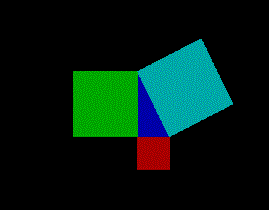Print out your Excel work and be sure to show work for our models from class and explain which model is better from your Excel solutions.
a) positive number >1,
b) a positive number <1, and
c) a negative number.
Be sure to label your original figure and the dilated figures and to explain in Sketchpad text comments (that also include your name) which figure is which. Attach your work to the personal storage space as yourfirstnamep4n3.gsp

|
The proof of the Pythagorean Theorem that we saw in project 1
was inspired by a figure that
was included in the book Vijaganita, (Root Calculations),
by the Hindu mathematician Bhaskara (around 1150 A.D.).
Bhaskara's only explanation of his proof was, simply, "Behold".
What you see is an animated version of Bhaskara's Idea.
A quote from
Math Awareness Month 2000 states:
|
Bhaskara also devised a proof of the Pythagorean Theorem based upon the notion of similar triangles. On the pdf Bhaskara's Similarity Proof (see also p. 151-152 of Wallace and West Roads to Geometry), fill in the details and reasons (using the appendix A of Euclid's Book 1 from Sibley The Geometric Viewpoint and the Similarity Postulates and Definitions from class [similar to what we did for the trig identity proof in class]).